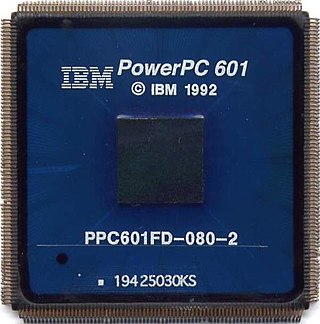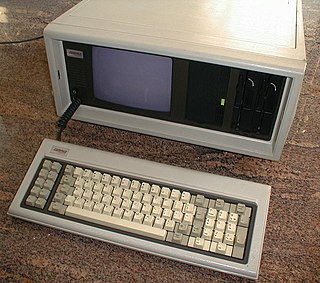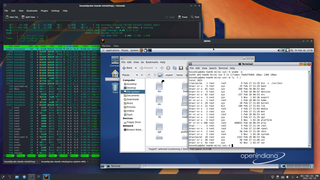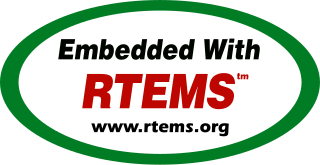
PowerPC is a reduced instruction set computer (RISC) instruction set architecture (ISA) created by the 1991 Apple–IBM–Motorola alliance, known as AIM. PowerPC, as an evolving instruction set, has been named Power ISA since 2006, while the old name lives on as a trademark for some implementations of Power Architecture–based processors.

The Power Macintosh, later Power Mac, is a family of personal computers designed, manufactured, and sold by Apple Computer, Inc as the core of the Macintosh brand from March 1994 until August 2006.

An IBM PC compatible is any personal computer that is hardware- and software-compatible with the IBM Personal Computer and its subsequent models. Like the original IBM PC, an IBM PC–compatible computer uses an x86-based central processing unit, sourced either from Intel or a second source like AMD, Cyrix or other vendors such as Texas Instruments, Fujitsu, OKI, Mitsubishi or NEC and is capable of using interchangeable commodity hardware such as expansion cards. Initially such computers were referred to as PC clones, IBM clones or IBM PC clones, but the term "IBM PC compatible" is now a historical description only, as the vast majority of microcomputers produced since the 1990s are IBM compatible. IBM itself no longer sells personal computers, having sold its division to Lenovo in 2005. "Wintel" is a similar description that is more commonly used for modern computers.

A workstation is a special computer designed for technical or scientific applications. Intended primarily to be used by a single user, they are commonly connected to a local area network and run multi-user operating systems. The term workstation has been used loosely to refer to everything from a mainframe computer terminal to a PC connected to a network, but the most common form refers to the class of hardware offered by several current and defunct companies such as Sun Microsystems, Silicon Graphics, Apollo Computer, DEC, HP, NeXT, and IBM which powered the 3D computer graphics revolution of the late 1990s.

The AIM alliance, also known as the PowerPC alliance, was formed on October 2, 1991, between Apple, IBM, and Motorola. Its goal was to create an industry-wide open-standard computing platform based on the POWER instruction set architecture. It was intended to solve legacy problems, future-proof the industry, and compete with Microsoft's monopoly and the Wintel duopoly. The alliance yielded the launch of Taligent, Kaleida Labs, the PowerPC CPU family, the Common Hardware Reference Platform (CHRP) hardware platform standard, and Apple's Power Macintosh computer line.
The PowerOpen Environment (POE), created in 1991 from the AIM alliance, is an open standard for running a Unix-based operating system on the PowerPC computer architecture.

Open Firmware is a standard defining the interfaces of a computer firmware system, formerly endorsed by the Institute of Electrical and Electronics Engineers (IEEE). It originated at Sun Microsystems where it was known as OpenBoot, and has been used by multiple vendors including Sun, Apple, IBM and ARM.

A/UX is a Unix-based operating system from Apple Computer for Macintosh computers, integrated with System 7's graphical interface and application compatibility. It is Apple's first official Unix-based operating system, launched in 1988 and discontinued in 1995 with version 3.1.1. A/UX requires select 68k-based Macintosh models with an FPU and a paged memory management unit (PMMU), including the Macintosh II, SE/30, Quadra, and Centris series.
Star Trek is the code name that was given to a secret prototype project, running a port of Macintosh System 7 and its applications on Intel-compatible x86 personal computers. The project, starting in February 1992, was conceived in collaboration between Apple Computer, who provided the majority of engineers, and Novell, who at the time was one of the leaders of cross-platform file-servers. The plan was that Novell would market the resulting OS as a challenge to Microsoft Windows, but the project was discontinued in 1993 and never released, although components were reused in other projects. The project was named after the Star Trek science fiction franchise with the slogan "To boldly go where no Mac has gone before".
Common Hardware Reference Platform (CHRP) is a standard system architecture for PowerPC-based computer systems published jointly by IBM and Apple in 1995. Like its predecessor PReP, it was conceptualized as a design to allow various operating systems to run on an industry standard hardware platform, and specified the use of Open Firmware and RTAS for machine abstraction purposes. Unlike PReP, CHRP incorporated elements of the Power Macintosh architecture and was intended to support the classic Mac OS and NetWare, in addition to the four operating systems that had been ported to PReP at the time.
The Advanced Computing Environment (ACE) was defined by an industry consortium in the early 1990s to be the next generation commodity computing platform, the successor to personal computers based on Intel's 32-bit instruction set architecture. The effort found little support in the market and dissolved due to infighting within the group and a lack of sales.
A hypervisor, also known as a virtual machine monitor (VMM) or virtualizer, is a type of computer software, firmware or hardware that creates and runs virtual machines. A computer on which a hypervisor runs one or more virtual machines is called a host machine, and each virtual machine is called a guest machine. The hypervisor presents the guest operating systems with a virtual operating platform and manages the execution of the guest operating systems. Unlike an emulator, the guest executes most instructions on the native hardware. Multiple instances of a variety of operating systems may share the virtualized hardware resources: for example, Linux, Windows, and macOS instances can all run on a single physical x86 machine. This contrasts with operating-system–level virtualization, where all instances must share a single kernel, though the guest operating systems can differ in user space, such as different Linux distributions with the same kernel.

The Quick Emulator (QEMU) is a free and open-source emulator that uses dynamic binary translation to emulate a computer's processor; that is, it translates the emulated binary codes to an equivalent binary format which is executed by the machine. It provides a variety of hardware and device models for the virtual machine, enabling it to run different guest operating systems. QEMU can be used with a Kernel-based Virtual Machine (KVM) to emulate hardware at near-native speeds. Additionally, it supports user-level processes, allowing applications compiled for one processor architecture to run on another.
The Intelligent Platform Management Interface (IPMI) is a set of computer interface specifications for an autonomous computer subsystem that provides management and monitoring capabilities independently of the host system's CPU, firmware and operating system. IPMI defines a set of interfaces used by system administrators for out-of-band management of computer systems and monitoring of their operation. For example, IPMI provides a way to manage a computer that may be powered off or otherwise unresponsive by using a network connection to the hardware rather than to an operating system or login shell. Another use case may be installing a custom operating system remotely. Without IPMI, installing a custom operating system may require an administrator to be physically present near the computer, insert a DVD or a USB flash drive containing the OS installer and complete the installation process using a monitor and a keyboard. Using IPMI, an administrator can mount an ISO image, simulate an installer DVD, and perform the installation remotely.

Real-Time Executive for Multiprocessor Systems (RTEMS), formerly Real-Time Executive for Missile Systems, and then Real-Time Executive for Military Systems, is a real-time operating system (RTOS) designed for embedded systems. It is free and open-source software.
Power Architecture Platform Reference (PAPR) is an initiative from Power.org to make a new open computing platform based on Power ISA processors. It follows two previous attempts made in the 1990s, PReP and CHRP.
In computing, virtualization is the use of a computer to simulate another computer. The following is a chronological list of virtualization technologies.
Microprocessors belonging to the PowerPC/Power ISA architecture family have been used in numerous applications.
Power.org was a global computer industry organization from 2004 to 2013, then succeeded by OpenPOWER Foundation, to develop and promote POWER Architecture technology by establishing its open standards, guidelines, best practices, and certifications.
WIMG is an acronym that describes that memory/cache attributes for PowerPC/Power ISA. Each letter of WIMG represents a one bit access attribute, specifically: Write-Through Access (W), Cache-Inhibited Access (I), Memory Coherence (M), and Guarded (G).








